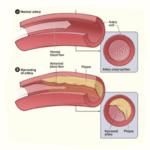There are a great many physiological effects of aging, one of those is the gradual hardening of the arteries. While this is a natural effect of aging, it sometimes causes a restriction in blood flow to organs, tissue, and peripherals. This condition is called Arteriosclerosis, and Atherosclerosis is one type of Arteriosclerosis. Arteriosclerosis can also occur earlier in life due to lifestyle choices, and it can be exacerbated in the elderly by the same lifestyle factors.
The arteries are blood vessels in the body that transport oxygen and nutrients to the aforementioned areas of the body (Mayo Clinic, 2006). The Mayo Clinic classifies healthy arteries as those that are “flexible, strong, and elastic” (2006). As we age this elasticity and strength initially prominent in the artery walls begins to harden becoming thick and inflexible. When the artery becomes too narrow to allow proper blood flow it affects the area where it carries oxygen and nutrients to. Another means of arterial damage is thought to be due to high blood pressure, high cholesterol, nicotine or other irritants, or certain diseases (Mayo Clinic, 2006). These factors can cause clots within the blood that can obstruct the arteries or those places that the arteries serve. Clots or other obstructions in the arteries serving the legs and arms can lead to pain and circulation problems. Atherosclerosis, the previously discussed form of arteriosclerosis can cause aneurysms posing a life threatening health risk.
Unfortunately, according to Merck Atherosclerosis is the “leading cause of morbidity and mortality in the U.S and in most Western countries...In the U.S its killed more than cancer and six times more than accidents” (2005). Merck goes on to predict that by 2020 “atherosclerosis is expected to be the leading cause of death worldwide” (2005). It’s too bad that this condition is generally spotted until it is causing or has caused a serious medical emergency. Perhaps this is why the mortality rate for atherosclerosis is so high. There are, however, some signs you can look for and have checked immediately if noticed. Chest tightness or pain, dizziness, weakness, numbness, pain in peripherals, or other symptoms of poor circulation can be caused by problems in the arteries and should be examined by a medical professional as soon as possible. Doctors also note that sexual dysfunction in men can be a sign of poor circulation and arterial problems.
As mentioned earlier, age isn’t the only factor that contributes to this condition. High blood pressure, obesity, smoking, family history of heart problems, diabetes, high cholesterol, and some nutritional factors such as vitamin deficiencies, or toxins such as pesticides. Doctors who treat Arteriosclerosis work aggressively to eliminate the risk factors that are creating or exacerbating the condition. This treatment also includes eliminating the lipids that can cause blood clots. According to the Mayo Clinic recent evidence suggests that “LDL should be higher than 70mg/dL, smoking should be dropped, and anti-clotting drugs used to treat the current problem” (2006). Additionally, any diseases that may aggravate the condition will be treated.
Diet is also a huge factor is the treatment and prevention of arteriosclerosis. A decrease in saturated fats and simple carbohydrates is key. For those seeking to avoid the build up of fats that can cause clots or create other risk factors for arteriosclerosis a diet following these requirements is recommended. Fruits and vegetables are valuable, as is fiber and proper vitamin intake. Just as these are treatments for the condition, they can prevent it from ever becoming a problem. What is important to note is that “small decreases in fat intake do not appear to lessen or stabilize atherosclerosis” (Mayo Clinic, 2006). In order to changes to be effective they must be drastic changes limiting fat intake to “twenty grams per day” and “five servings of fruit and vegetables a day” (Mayo Clinic, 2006).
While the stiffening of the arteries is natural and unpreventable, the elderly can lessen their chances through lifestyle choices. Those younger in life should work at an early age to change habits. Arteriosclerosis and atherosclerosis are serious conditions and claim far too many lives as it is. It’s time to work to prevent clotting and risk factors for the condition in our youth, and properly treat the problem in the elderly.
References:
Mayo Clinic. (2006). Arteriosclerosis / Atherosclerosis. Retrieved June 11, 2007, from May Clinic Website: http://www.mayoclinic.com/health/arteriosclerosis-atherosclerosis/DS00525
Merck. (2005). Atherosclerosis. Retrieved June 11, 2007, from Merck Website: http://www.merck.com/mmpe/sec07/ch072/ch072b.html


